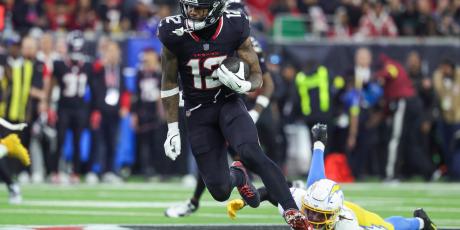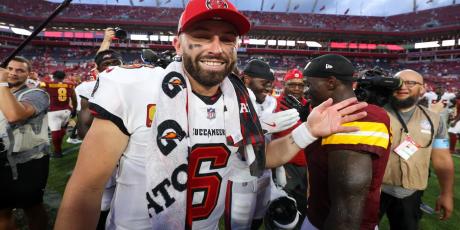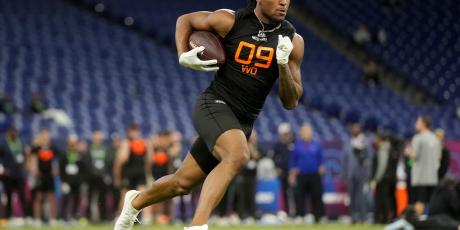DraftKings Best Ball Tournament Strategy

DraftKings recently launched its best ball product, including two massive tournaments, the $3 Play-Action and the $20 Millionaire. Here is the structure for each tournament.
| DraftKings Best Ball Contest | Buy-in | Entries | 1st place | Places Paid | # of Entries Advance to Round 2 (Week 14) | # of Entries Advance to Round 3 (Week 15) | Championship Round Entries (Week 16) | |
|---|---|---|---|---|---|---|---|---|
| Millionaire | $20 | 172,800 | $1,000,000 | 43,200 | 14,400 | 1,200 | 100 | Enter Now! |
| Play-Action | $3 | 216,000 | $50,000 | 54,000 | 18,000 | 1,500 | 125 | Enter Now! |
The following will breakdown strategies for large-field best ball tournaments such as these.
For those new to best ball, be sure to check out 4for4’s Intro to Best Ball Leagues. Get familiar with general best ball strategy here.
Stacking
Stacking is a fundamental concept in DFS but it is still under-utilized in redraft leagues. This roster-building technique pairs multiple players from the same team in an effort to create lineup volatility. While a head-to-head format—such as a traditional redraft league—can encourage managers to focus on their team’s floor, there are few ways to get built-in upside in fantasy like stacking. In top-heavy payout leagues like many popular best-ball formats, targeting upside is extremely beneficial—in a massive tournament, it’s a virtual must.
Unlike DFS, we don’t always have access to every player in best ball since we are at the mercy of the snake draft. While it’s a good idea to plan out which offenses you would like to have heavy exposure to, the reality is that players you are hoping to land won’t always be there when your pick comes around. Rather than building teams around a stack, as is often the starting point in DFS tournaments, best ball stacks should come second to an optimal draft strategy, in terms of position allocation and player value.
Consider this scenario. You’ve come to the conclusion that the Bills are a sneaky pick to be one of the best passing offenses in the league and want to stack their passing game on one of your DraftKings Millionaire teams. Stefon Diggs went a little earlier than expected but you still get Josh Allen at his ADP. John Brown is an extremely affordable option to add to your roster and since he’s been moving down draft boards, you opt to get your TE2 in Round 10 since Brown should still be there in the 11th—except he goes one pick later. In this situation, simply pivot your plan to stack one of the pass-catchers that you have already drafted with your next quarterback. Maybe T.J. Hockenson was the tight end you picked as your TE2. Come back and grab Matthew Stafford at cost.
With all that said, there is merit to forcing some stacks for some of the more expensive offenses in the league. If the plan is to stack the Chiefs offense, decide how often you want to do that and go into a set number of drafts prepared to spend multiple early-round picks on Kansas City players—this includes being willing to spend an early pick on a quarterback, occasionally, a redraft faux pas.
Listen to Chris Raybon discuss how he is attacking the DraftKings Millionaire on this recent episode of the DFS MVP Podcast.
Player Exposure
The idea of managing player exposure—how many times you draft a specific player—is valuable in best ball. Those playing hundreds, or even thousands, of leagues across multiple platforms and trying to squeeze out a profitable win rate in a collection of 12-man leagues benefit from knowing when they are drafting players too often; they save their floor by having at least a few shares of players that they don’t like.
In a contest where you are looking to top 100,000+ other entries, having concerns about your team’s or portfolio’s floor is a futile effort.
Because we are at the mercy of the snake draft, it will be tough to get your favorite players from the early rounds as often as you’d like. It’s rare—impossible almost—to get a top-three running back without a top-three pick. In the later rounds, however, having 100% exposure to one of your favorite handcuffs or fliers may be an optimal strategy.
One caveat to this is staying aware of how exposed you are to your favorite offenses. While you can’t always control how a single draft will go, there is more control over how often you draft players from specific offenses across all of your teams. As my portfolio stands now, Eagles players account for 7.3% of my roster spots while 5.8% of my players are Bills. It will be tough to have team exposure much higher than this.
Gaining Leverage and Building Unique Lineups
Low-Owned Players
In order to win a large-field tournament, a roster must be unique. That’s usually achieved in DFS lineups by having players with low ownership. Best ball leagues don’t offer that option, at least not on as wide of a scale—almost every relevant player will be drafted in 100% of leagues.
Where fantasy managers can be unique is at the very end of drafts. Players extremely low on depth charts may go undrafted in many leagues. By having exposure to some players that might not even have an ADP, you can set yourself up to have the only occurrence of your exact roster. Think of players such as D.J. Chark or Terry Mclaurin, who were mostly undrafted last year, but ended up posting starter-caliber numbers late in the season.
Athletic rookies or players early in their careers in ambiguous positional situations are often perfect targets late in drafts. Other drafters are wary of drafting an unproven talent or not getting fantasy production early on in the season, but that risk is outweighed not only by the uniqueness of the lineup but the upside late in the season when there is the most benefit to running away from the field—payouts increase rapidly in Weeks 14–16.
Unique Roster Construction
There are some ways to build your roster that can be unique. The general consensus is that each roster should be made up of 2–3 quarterbacks, tight ends and defenses, 5–6 running backs, and 7–8 wide receivers. How you get there will depend on the draft—anyone who spends up at quarterback or tight end, for example, will usually only roster two players at the position and wait until the later rounds to draft a backup. Some options to consider to get away from the status quo include:
- Doubling up on early-round talent at quarterback or tight end - Very few teams will be willing to take two of the top five or six players at either of these positions. Those that do could walk away with two explosive stacks, rather than just one stack that they fell into.
- Rostering one player at a “onesie” position - This is an “all-in” strategy but it could pay dividends. The idea is that you are willing to take a zero for one week at a position in hopes that the player you drafted there dominates every other week.
- Positional extremes - Hyperfragile and Zero RB draft strategies are just a couple examples of how to build a unique roster predicated entirely on upside.
- Onslaughts - This takes stacking to the extreme. There is no rigid definition but in this format, any roster with four or more players from one offense is probably worthy of this moniker.
These aren’t the only ways to go against the grain but some ideas to get you in a contrarian mindset. As mentioned in the stacking section, unique approaches should complement an optimal draft strategy. Used sparingly, the techniques laid out here will certainly help you differentiate your lineups from the field.
The Bottom Line
Best ball leagues are the perfect option for anyone looking for a new league with less work to do throughout the season or for those whose leagues might be on hold because of the uncertainty surrounding the season. DraftKings’ huge prize pools make the prospects of best ball even more intriguing. After understanding the basics of best ball strategy, drafters entering large-field tournaments should explore how they can maximize upside while also building unique rosters. Those who haven't signed up for a best ball league yet can get started here.






















